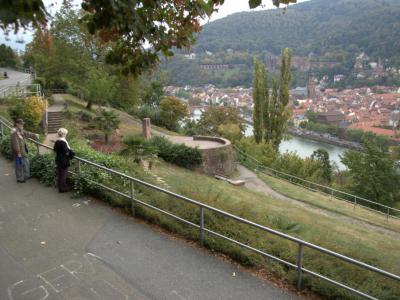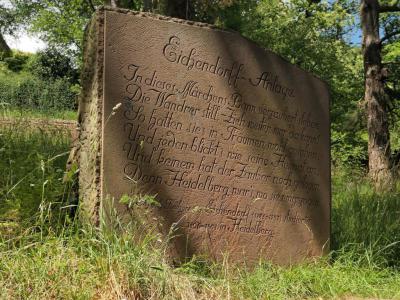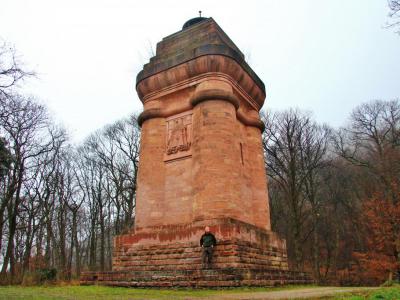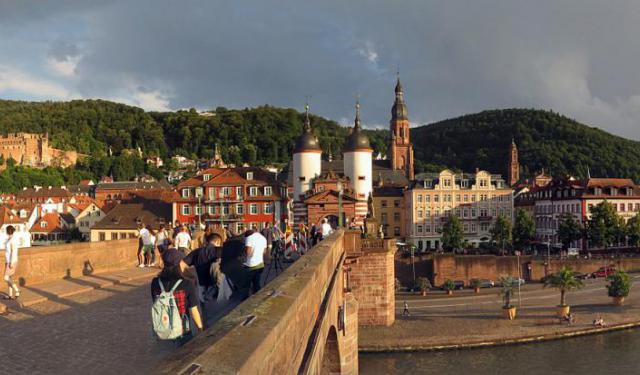
Philosophers’ Path (Self Guided), Heidelberg
Heidelberg may be famous for its Castle, Old Town, and University, but its attractions don't stop there. A trip to Heidelberg isn't complete without visiting the Philosopher's Path.
Located on the northern side of the Neckar River, this popular path, about two kilometers long, meander along the sunny side of Holy Mountain. Over the centuries, it has inspired numerous scholars and poets and is rightfully regarded as one of the most beautiful walkways in Europe.
Historically, it was just a simple rough path through the vineyards. During the Romantic Period, it acquired its current name due to the many professors and philosophers of Heidelberg who frequented it. Today, the walk remains picturesque, with informational plaques and many benches where visitors can pause and enjoy the unmatched panorama.
One of the first landmarks to behold is the exotic vegetation of the Philosophers' Garden, followed by Eichendorff Park, which is located below the Bismarck Tower—a massive stone pillar with columns, erected in 1900 as a memorial to Bismarck two years after his death.
To get a good idea of how Heidelberg looked in the old days, check out Merian's View, a 1620 copperplate engraving that illustrates the original city. It's also worth walking to the Snake Path, which offers excellent panoramic views of Heidelberg.
All in all, to enjoy the solitude, natural beauty, and stunning views that once appealed to Romantic artists and philosophers, take this self-guided tour of the Philosopher's Path.
Located on the northern side of the Neckar River, this popular path, about two kilometers long, meander along the sunny side of Holy Mountain. Over the centuries, it has inspired numerous scholars and poets and is rightfully regarded as one of the most beautiful walkways in Europe.
Historically, it was just a simple rough path through the vineyards. During the Romantic Period, it acquired its current name due to the many professors and philosophers of Heidelberg who frequented it. Today, the walk remains picturesque, with informational plaques and many benches where visitors can pause and enjoy the unmatched panorama.
One of the first landmarks to behold is the exotic vegetation of the Philosophers' Garden, followed by Eichendorff Park, which is located below the Bismarck Tower—a massive stone pillar with columns, erected in 1900 as a memorial to Bismarck two years after his death.
To get a good idea of how Heidelberg looked in the old days, check out Merian's View, a 1620 copperplate engraving that illustrates the original city. It's also worth walking to the Snake Path, which offers excellent panoramic views of Heidelberg.
All in all, to enjoy the solitude, natural beauty, and stunning views that once appealed to Romantic artists and philosophers, take this self-guided tour of the Philosopher's Path.
How it works: Download the app "GPSmyCity: Walks in 1K+ Cities" from Apple App Store or Google Play Store to your mobile phone or tablet. The app turns your mobile device into a personal tour guide and its built-in GPS navigation functions guide you from one tour stop to next. The app works offline, so no data plan is needed when traveling abroad.
Philosophers’ Path Map
Guide Name: Philosophers’ Path
Guide Location: Germany » Heidelberg (See other walking tours in Heidelberg)
Guide Type: Self-guided Walking Tour (Sightseeing)
# of Attractions: 6
Tour Duration: 1 Hour(s)
Travel Distance: 1.6 Km or 1 Miles
Author: nicole
Sight(s) Featured in This Guide:
Guide Location: Germany » Heidelberg (See other walking tours in Heidelberg)
Guide Type: Self-guided Walking Tour (Sightseeing)
# of Attractions: 6
Tour Duration: 1 Hour(s)
Travel Distance: 1.6 Km or 1 Miles
Author: nicole
Sight(s) Featured in This Guide:
- Philosophenweg-Eingang (Philosophers' Path Entrance)
- Philosophengartchen (Philosophers' Garden)
- Eichendorff-Anlage (Eichendorff Park)
- Bismarck-Saule (Bismarck Tower)
- Merianblick (Merian's View)
- Schlangenweg (Snake Path)
1) Philosophenweg-Eingang (Philosophers' Path Entrance)
The entrance to the Philosophers' Path, although signposted at the end of the Old Bridge ("Alte Brücke"), can be somewhat hidden from view and may be challenging for non-residents to find. However, if you manage to locate it and follow the path, you'll soon find yourself on the Philosophenweg, which passes through one of Heidelberg's finest and most exclusive residential areas, Neuenheim. The initial ascent of 700 meters may feel strenuous, but the effort is well worth it.
Once you've conquered the uphill climb, you'll be rewarded with breathtaking views of Heidelberg Castle, the Old Town, and the surrounding area, stretching all the way to the Palatinate Mountains. The sight of the Königstuhl viewpoint, accessible by funicular above the castle, adds to the impressive panorama.
Along the path, stone benches and the Philosophers' Garden ("Philosophengärtchen") invite visitors to pause and take in the scenery at their leisure. These tranquil spots provide the perfect opportunity to reflect on the beauty of the landscape and perhaps engage in some philosophical contemplation, as the name suggests.
Once you've conquered the uphill climb, you'll be rewarded with breathtaking views of Heidelberg Castle, the Old Town, and the surrounding area, stretching all the way to the Palatinate Mountains. The sight of the Königstuhl viewpoint, accessible by funicular above the castle, adds to the impressive panorama.
Along the path, stone benches and the Philosophers' Garden ("Philosophengärtchen") invite visitors to pause and take in the scenery at their leisure. These tranquil spots provide the perfect opportunity to reflect on the beauty of the landscape and perhaps engage in some philosophical contemplation, as the name suggests.
2) Philosophengartchen (Philosophers' Garden) (must see)
This beautiful, sun-soaked garden feels like a natural balcony, filled with a variety of exotic plants. Thanks to the mild climate along the Philosopher's Path, many plants from subtropical regions, such as almond trees, lemon trees, and ginkgo trees, thrive here and have become native to the area.
The garden offers a lovely view of the city. You can relax on one of the benches or the beautiful grassy areas, breathing in the fresh air while taking in the scenery. Keep in mind that it's a hilltop area, so bring a water bottle and wear good shoes, as it can get quite slippery when wet. It's definitely a spot you won't want to miss, perfect for photos.
The garden offers a lovely view of the city. You can relax on one of the benches or the beautiful grassy areas, breathing in the fresh air while taking in the scenery. Keep in mind that it's a hilltop area, so bring a water bottle and wear good shoes, as it can get quite slippery when wet. It's definitely a spot you won't want to miss, perfect for photos.
3) Eichendorff-Anlage (Eichendorff Park)
On your way to the highest point of Heiligenberg, you'll come across the Eichendorff-Anlage, a charming little park below the Bismarck Tower that invites you to linger.
Few poets have shaped the image of Heidelberg as the City of Romanticism more than Joseph von Eichendorff in his later works. Reflecting on the passage of space and time with an idealistic view, Eichendorff evoked the emotions of bygone days in the opening and closing lines of his 1855 narrative poem "Robert and Guiscard". Heidelberg, where he studied law, philosophy, and literature from 1807 to 1808, is portrayed as a fairytale realm of Romantic longing and unrestrained youth. A commemorative plaque on the mountainside of the park features an excerpt from his famous poem, written two years before his death.
Few poets have shaped the image of Heidelberg as the City of Romanticism more than Joseph von Eichendorff in his later works. Reflecting on the passage of space and time with an idealistic view, Eichendorff evoked the emotions of bygone days in the opening and closing lines of his 1855 narrative poem "Robert and Guiscard". Heidelberg, where he studied law, philosophy, and literature from 1807 to 1808, is portrayed as a fairytale realm of Romantic longing and unrestrained youth. A commemorative plaque on the mountainside of the park features an excerpt from his famous poem, written two years before his death.
4) Bismarck-Saule (Bismarck Tower)
A Bismarck Tower is a specific type of monument built in a mostly standardized design throughout Germany to honor the country's first chancellor, Otto von Bismarck (d. 1898). Approximately 240 of these towers have been cataloged, all constructed between 1869 and 1934, with around 173 still standing today.
Each Bismarck Tower was designed as a beacon, with their braziers lit on specific days to commemorate Bismarck's role in unifying Germany in 1871. While most towers included fire installations, the plan for a nationwide beaconing event did not materialize, leading many local initiatives to adopt unique designs. A notable architect involved in these projects was Wilhelm Kreis, who erected 58 towers.
The Bismarck Tower near Eichendorff-Anlage park in Heidelberg was built in 1903 and features a relief of an eagle with the serpent of discord. At its summit sits a cast-iron fire bowl about eight feet in diameter. Visitors can enter the tower and climb the steps to enjoy an impressive view of Heidelberg's Old Town and the surrounding area.
Each Bismarck Tower was designed as a beacon, with their braziers lit on specific days to commemorate Bismarck's role in unifying Germany in 1871. While most towers included fire installations, the plan for a nationwide beaconing event did not materialize, leading many local initiatives to adopt unique designs. A notable architect involved in these projects was Wilhelm Kreis, who erected 58 towers.
The Bismarck Tower near Eichendorff-Anlage park in Heidelberg was built in 1903 and features a relief of an eagle with the serpent of discord. At its summit sits a cast-iron fire bowl about eight feet in diameter. Visitors can enter the tower and climb the steps to enjoy an impressive view of Heidelberg's Old Town and the surrounding area.
5) Merianblick (Merian's View)
To get a glimpse of how Heidelberg looked before any of the wars began, follow the Philosophers' Path to Merianblick, or Merian's View. This sandstone platform features an copperplate engraving of Heidelberg from the 1620s, allowing tourists to compare the historical map with the present-day city. The map depicts the city before the Thirty Years' War (1618-1648) within the Holy Roman Empire, which led to Heidelberg's destruction. The engraving itself was created by Matthaus Merian, a Swiss artist known for his topographical works.
6) Schlangenweg (Snake Path)
Known as the Snake Path due to its many winding switchbacks, this footpath connects the Old Bridge to the Philosophers' Path. Stretching nearly 500 meters and climbing about 90 meters in elevation, it is largely carved into the hillside, featuring several switchbacks flanked by red sandstone walls. Originally a vineyard trail, it led to the vineyards on the south-facing slope above the Neckar, which were part of the village of Neuenheim, incorporated into Heidelberg in 1891. Today, this area is home to gardens and developed properties.
The Snake Path was renovated in 1782, with steps added. At two of the switchbacks, there are stone lookouts with shaded benches offering spectacular views of Heidelberg's Old Town. The numerous dry stone walls make the path a valuable habitat for heat-loving species like the wall lizard. Additionally, along the path, you can find medlar trees, a once significant but now rare fruit tree species.
The Snake Path was renovated in 1782, with steps added. At two of the switchbacks, there are stone lookouts with shaded benches offering spectacular views of Heidelberg's Old Town. The numerous dry stone walls make the path a valuable habitat for heat-loving species like the wall lizard. Additionally, along the path, you can find medlar trees, a once significant but now rare fruit tree species.
Walking Tours in Heidelberg, Germany
Create Your Own Walk in Heidelberg
Creating your own self-guided walk in Heidelberg is easy and fun. Choose the city attractions that you want to see and a walk route map will be created just for you. You can even set your hotel as the start point of the walk.
Heidelberg Introduction Walking Tour
Heidelberg is located on the Neckar River and is Baden-Württemberg’s fifth-largest city. One-quarter of the approximately 160,000 residents are students. Heidelberg University was founded in 1386 and is Germany’s oldest and one of Europe’s most prestigious universities. In addition, Heidelberg is home to internationally acclaimed research facilities, including four Max Planck Institutes.... view more
Tour Duration: 2 Hour(s)
Travel Distance: 2.0 Km or 1.2 Miles
Tour Duration: 2 Hour(s)
Travel Distance: 2.0 Km or 1.2 Miles
The Most Popular Cities
/ view all







